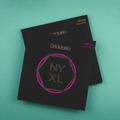Gauge is just a number
By Strings Direct – 29 August, 2023
 String gauge can be a really funny thing.
String brands use a whole myriad of names to describe the gauge of their strings. Here’s just a handful of the names that we’ve come across;
Light, super light, extra-light, super-light plus, light, regular light, regular, slightly light, custom light, bluegrass, light top-heavy bottom, medium, new medium, true medium, standard medium, medium-heavy, heavy, heavier, heaviest.
Phew!?...and we could probably go on!!
String manufacturers will give these little names to their sets to help give a more ‘descriptive’ meaning to the gauge itself. However, these names can often cause confusion particularly when trying to compare sets across different string brands.
Let us briefly explain. Three sets of acoustic guitar strings from 3 different string brands may all have the same gauge (e.g. 12-53). However, one brand may describe their gauge as ‘Light’, another brand could call their set ‘Medium Light’ and somebody else’s could be referred to as ‘Medium.’ So you can see where the confusion comes into play. Not all brands follow suit and this can often mislead players into thinking that all sets referred to as ‘Light’ gauge are the same gauge, all sets described as ‘Medium’ are the same and so on. However, what it really boils down to is, regardless of how these sets are labelled or described, all three in the example given are the exact same thickness (12-53) and this is what you should really focus on. It’s the numbers that matter, not the names.
We often see players make their choice on string gauge based on the descriptive name, and whilst there is not a problem with that, that is all it is…. a name. The physical gauge (09-42, 10-46 etc.) is what is key here and what actually describes how thick the string really is.
As an example, a few brands refer to their 12-56 gauge acoustic strings as a ‘Bluegrass’ set. The gauge is really just a typical set of 12-53 strings with a slightly heavier bottom end. However, a name such as ‘Bluegrass’ shouldn’t deter players from choosing that gauge just because they don’t play that particular style of music. Likewise, if you do play Bluegrass music, it doesn’t mean that this is the only gauge that will ‘sound right’ when you play this style of music.
String gauge can be a really funny thing.
String brands use a whole myriad of names to describe the gauge of their strings. Here’s just a handful of the names that we’ve come across;
Light, super light, extra-light, super-light plus, light, regular light, regular, slightly light, custom light, bluegrass, light top-heavy bottom, medium, new medium, true medium, standard medium, medium-heavy, heavy, heavier, heaviest.
Phew!?...and we could probably go on!!
String manufacturers will give these little names to their sets to help give a more ‘descriptive’ meaning to the gauge itself. However, these names can often cause confusion particularly when trying to compare sets across different string brands.
Let us briefly explain. Three sets of acoustic guitar strings from 3 different string brands may all have the same gauge (e.g. 12-53). However, one brand may describe their gauge as ‘Light’, another brand could call their set ‘Medium Light’ and somebody else’s could be referred to as ‘Medium.’ So you can see where the confusion comes into play. Not all brands follow suit and this can often mislead players into thinking that all sets referred to as ‘Light’ gauge are the same gauge, all sets described as ‘Medium’ are the same and so on. However, what it really boils down to is, regardless of how these sets are labelled or described, all three in the example given are the exact same thickness (12-53) and this is what you should really focus on. It’s the numbers that matter, not the names.
We often see players make their choice on string gauge based on the descriptive name, and whilst there is not a problem with that, that is all it is…. a name. The physical gauge (09-42, 10-46 etc.) is what is key here and what actually describes how thick the string really is.
As an example, a few brands refer to their 12-56 gauge acoustic strings as a ‘Bluegrass’ set. The gauge is really just a typical set of 12-53 strings with a slightly heavier bottom end. However, a name such as ‘Bluegrass’ shouldn’t deter players from choosing that gauge just because they don’t play that particular style of music. Likewise, if you do play Bluegrass music, it doesn’t mean that this is the only gauge that will ‘sound right’ when you play this style of music.
So why do string manufacturers do this and not just use the numbers only?
One reason brands use names like ‘Light’ and ‘Medium’ is to help guide players when choosing a set of strings. This is especially true for players that may be newer to an instrument. If a beginner doesn’t know what a gauge of string even is, we completely sympathise when they come over in a cold sweat when met with a barrage of gauge options. It’s much easier to make a decision when met given the choice between ‘extra light’, ‘light’ and ‘medium’ as opposed to 09-42, 10-46 or 11-49 when you may not know what the hell those seemingly random group of numbers even mean. String makers also do this to help give their sets a bit of individuality. Ernie Ball of course being the best example of this with there infamous Slinky branded strings e.g. Regular Slinky, Extra Slinky, Super Slinky etc. Whilst these are great unique names that are world renowned, without being given the 10-46 gauge for clarity, you wouldn’t necessarily know what gauge the term ‘Regular Slinky’ actually refers to.So what should I do if I’m testing out different brands?
Well, if you know what gauge you use by the numbers as opposed to the name, you’ll always be on solid ground and in a better position to make a more accurate choice. As we’ve mentioned before, the names can contradict one another so by following the numbers it’ll make the transition between brands a lot easier. For example if you have a set of D'Addario EJ16 12-53 Light Gauge strings on your acoustic guitar but wanted to try the equivalent gauge in Ernie Ball’s Earthwood range, if you look for the the numbers (12-53) you’ll be sure to get the comparable gauge set. However, if you were to look by name instead, you’ll end up with a different gauge. This is because D'Addario refer to their 12-53 set as ‘Light’ whereas Ernie Ball’s ‘Light’ gauge is in fact 11-52. So what we’re saying here is;
So what we’re saying here is;
a ‘12-53 Light Gauge’ set IS THE SAME GAUGE as a ‘12-53 Medium Light’ gauge set. (Because the numbers match up)
But….
a ‘12-53 Light Gauge’ set IS NOT THE SAME as a set of ‘11-52 Light Gauge’ strings. (Because the numbers do not match up) If you chop and change sets often but struggle to remember what set you have on your guitar, when you next change a set, instead of throwing your string packets away just keep the outer packaging and pop it in your guitar case or gig bag. Sounds silly but you’ll always know what’s on there when it comes to choosing your next set. We hope this has given you some insight into gauges a little bit more and helped make your decision on your next set of strings a little bit easier. As always, you can contact us by telephone, e-mail, social media, smoke signal (actually not that one!) and we’ll always be happy to give you guidance where we can. Thanks for reading, until next time....
You know what strings you're after now, but do you know how to restring your guitar properly?





